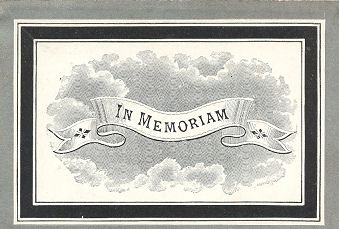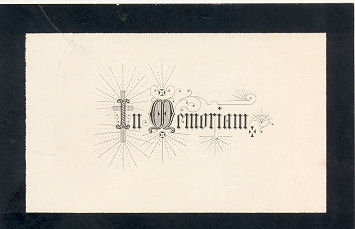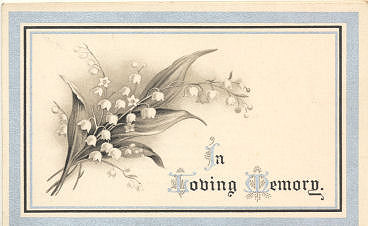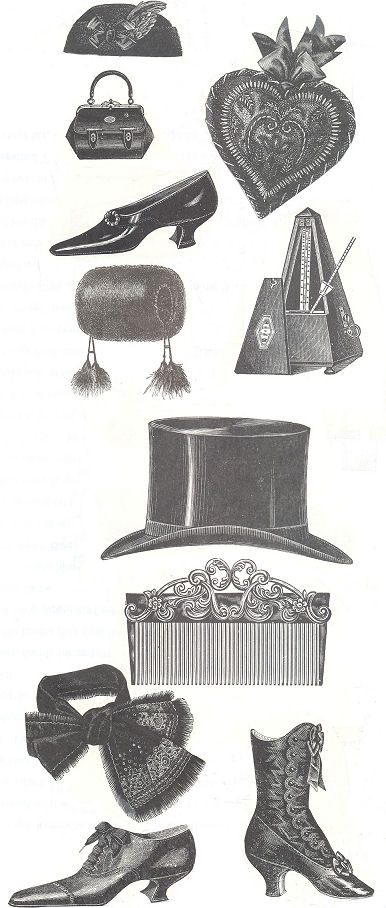
 |
VICTORIAN MOURNING
In some ways, this is a
book about death, or the obsession with death that permeated Victorian
society. It was a strange mix of sentimentality, morbid fear and snobbery.
Above all, it was about shopping. The Mourning Emporium of the title is a
kind of department store. It advertises itself like this:

|


 |



|
Here is an extract from the
book that shows what Teo and Renzo see when they are first taken inside
the Mansion Dolorous by the London street children who have befriended
them:
'What the bucket ... !' exclaimed Teo, and then she too was silenced by
the prospect that began to emerge in front of them as the Londoners darted
about like fireflies, lighting ornamented gas-lamps.
'A warehouse full of mourning vestments' did not
even begin to describe this Aladdin's Cave of jet-black merchandise. The
walls of the Mansion Dolorous were divided into towering caverns warmed by
glowing grates at regular intervals. Racks of dresses stretched into the
distance until they congealed into a slew of blackness. There were solidly
packed shelves of black-edged stationery, visiting cards and envelopes.
Teo glimpsed a card that read, 'You are desired to accompany the corpse of
'' with a blank left for a name. There were perfume bottles bedecked with
black ribbons. Black gloves were neatly folded on trolleys next to rolls
of black braiding trimmed with beads and sequins, black fringes, silk and
jet drops. There were crisply pleated silk mourning fans mounted on
ebonized sticks, black feather boas coiled in rustling black nests, and
white mourning handkerchiefs embroidered with black teardrops. There were
mourning cockades for coachmen's hats. An immense haberdashery cupboard
was honeycombed with compartments for black hairpins, black rosettes and
black armbands.
Mourning jewellery winked sombrely from
glass-topped cases. Renzo and Teo bent over a display of brooches made of
human hair plaited and shaped into patterns and set behind glass. Other
brooches showed dim daguerreotypes of sad faces. There were gold mourning
rings inset with black enamel, grey and black pearls, shiny jet bracelets,
scarf pins, tiaras, jewelled and feathered hair combs, lockets, pendants
and cameos with white profiles etched on onyx backgrounds. There were
mourning lampshades in Chinese pongee silk and mourning bookmarks
embroidered with forget-me-nots and doleful poems. There were black
funeral teapots and associated teaplates, and even a mourning ear trumpet
in vulcanite, horribly reminiscent of a black bat. And immortal wreaths of
flowers fashioned from Parian and silk, stiff and white under glass domes.
'How the English love death!' marvelled Teo.
'They seem to enjoy dying more than living. They must spend more money on
it anyway.'
'You haint wrong,' affirmed Hyrum Hoxton. 'And
this haint even the biggest mournin' emporium in London Town. You should
see Jay's in Regent Street. They is our deadly rivals. We hates em loik
poison.'
 |
|
Tristesse & Ganorus's Mansion Dolorous Mourning Emporium is invented, but
it is very like two London magasins de deuil or mourning
warehouses. Jay's London General Mourning Warehouse opened at 248-9 Regent
Street in 1841. Peter Robinson's Court and General Mourning Warehouse in
Regent Street was founded in the 1850s. Even Harrods had a large mourning
department, including coffins, gravestones and every possible item of
mourning fashion. Dottridge's in the East Road was the wholesaler for all
funeral supplies. There, the coffins were made, the marble tombstones
carved and funeral carriages constructed.
Jay's
published its own heavily illustrated book by Richard Davey. A History
of Mourning describes the warehouse as a place where 'people in the
haste of grief can obtain in a few hours all that the etiquette of
civilization requires for mourning'.
That
'all', as this story shows, was a considerable amount.
People
desired a good funeral as a sign of their social station. Even very poor
people would subscribe to funeral funds, also known as burial funds, to
have the comfort of knowing that they would have a respectable
'sending-off' and not a shameful pauper's funeral. There was a widespread
belief in the profitable superstition that a brand-new mourning dress
should be bought for each death.
The
rules of mourning were strictly observed in society. Briefly, a widow was
expected to wear mourning for two years; the mother of a dead child, or a
bereaved child, twelve months. A dead sibling required six months'
mourning. But the etiquette and society magazines argued obsessively about
the minor details of even these matters.
The
high point of extravagant funerals was probably in the 1850s. The Duke of
Wellington's spectacular funeral was the last word in splendour, and
provoked something of a backlash. By the time of this story, the
Victorians had begun to praise more modest arrangements and accoutrements,
and to relax some of the more absurd refinements.
Church attendance was particularly heavy all over
the kingdom. The Sunday sermons openly spoke of the great loss that was to
befall the nation. The Times reported a sense of impending sadness from
Calcutta to Cape Town. The New York Times headlined with: QUEEN VICTORIA
AT DEATH'S DOOR '
The very stones of London seemed to
quiver with unspent tears and ancient frights; the river drew back from
its banks in an unprecedented low tide, like a bared grin of terror. Some
of London's long-suppressed ghosts began to grow more substantial, though
still weak and uncertain of their own existence. They emerged from their
hiding places and flitted about Kensington Gardens and Hyde Park, almost
indistinguishable from the mist.
|


|
|
But
naturally, Queen Victoria's death provoked a final run on the mourning
emporia. On the days following her funeral, many people wore black. On the
day of the funeral itself it was hard to see anyone not dressed in weeds
among the crowds in London and Windsor. Queen Victoria herself, however,
had specified funeral decorations in purple and white.
|

|
|
At the end of the meal, Sibella produced a small,beautifully accurate black bear with button eyes and a dear little paunch.
‘Pray what is that?’ asked Mr Ganorus.
‘A Mourning Bear,’ replied Sibella.
‘A toy bear? It’ll never take on,’ frowned Mr Tristesse. ‘What child in its right mind would want to hug a bear and take it to bed?’ |

|




